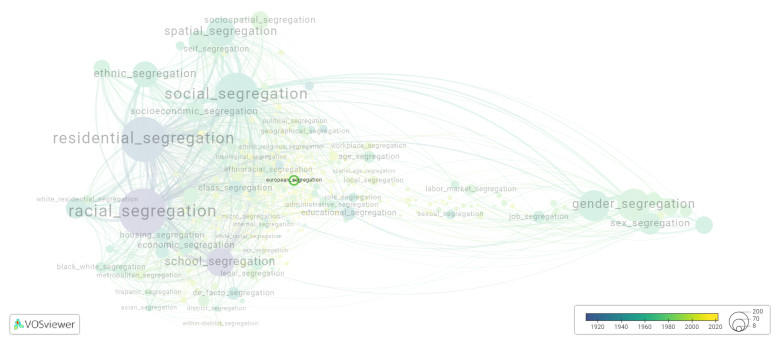European segregation: Difference between revisions
(Creating page) |
(Creating page) |
||
| Line 18: | Line 18: | ||
[[File:european_segregation.png|780x780px]] | [[File:european_segregation.png|780x780px]] | ||
This visualization is based on the study [[ | This visualization is based on the study [[Segregation_Wiki:About| The Multidisciplinary Landscape of Segregation Research]]. | ||
For the complete network of interrelated segregation forms, please refer to: | For the complete network of interrelated segregation forms, please refer to: | ||
Latest revision as of 07:17, 16 October 2024
Date and country of first publication[1][edit | edit source]
1992
South Africa
Definition[edit | edit source]
European segregation refers to the social and spatial separation of different racial, ethnic, or religious groups within European societies. It can manifest in various forms, such as residential segregation (where different groups live in different neighborhoods), educational segregation (where different groups attend different schools), or employment segregation (where certain jobs or industries are dominated by specific groups).
Segregation in Europe has historical roots that can be traced back to colonialism, immigration, and the existence of entrenched social hierarchies. Immigrants and their descendants from former colonies often face barriers and discrimination that contribute to their segregation from the majority population. In some cases, there may also be self-segregation, where communities voluntarily separate themselves due to shared cultural or religious beliefs.
The consequences of European segregation are diverse and far-reaching. Segregated communities may experience limited access to resources, poorer educational opportunities, higher crime rates, and social exclusion. This can lead to stigmatization, discrimination, and the perpetuation of social inequalities. Moreover, segregation can hinder social cohesion and integration, potentially resulting in tensions and conflicts within society.
Efforts to address European segregation include policies aimed at promoting diversity, integration, and equal opportunities. These policies strive to create inclusive societies, improve access to education and employment, combat discrimination, and foster greater interaction and social mixing between different groups. However, progress in these areas varies across European countries, and more work is needed to ensure that all individuals have equal opportunities and rights, regardless of their background.
See also[edit | edit source]
Related segregation forms[edit | edit source]
European segregation is frequently discussed in the literature with the following segregation forms:
This visualization is based on the study The Multidisciplinary Landscape of Segregation Research.
For the complete network of interrelated segregation forms, please refer to:
References[edit | edit source]
Notes[edit | edit source]
- ↑ Date and country of first publication as informed by the Scopus database (December 2023).
At its current state, this definition has been generated by a Large Language Model (LLM) so far without review by an independent researcher or a member of the curating team of segregation experts that keep the Segregation Wiki online. While we strive for accuracy, we cannot guarantee its reliability, completeness and timeliness. Please use this content with caution and verify information as needed. Also, feel free to improve on the definition as you see fit, including the use of references and other informational resources. We value your input in enhancing the quality and accuracy of the definitions of segregation forms collectively offered in the Segregation Wiki ©.
European segregation appears in the following literature[edit | edit source]
Christopher A.J. (1992). Urban segregation levels in the British overseas empire and its successors, in the twentieth century. Transactions - Institute of British Geographers, 17(1), 95-107. https://doi.org/10.2307/622639

